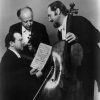Ravel: Piano Trio in A minor
Maurice Ravel’s Piano Trio, composed in 1914 and first performed in Paris in January 1915, is a chamber piece for piano, violin, and cello, lasting about 30 minutes. Dedicated to his counterpoint teacher, André Gedalge, the trio reflects Ravel’s deep connection to his Basque heritage, especially in the opening movement, which draws on Basque influences.
Ravel began planning the trio six years before its completion and worked intensively during the summer of 1914 in Saint-Jean-de-Luz. Initially progressing slowly, the outbreak of World War I motivated Ravel to complete the trio swiftly so he could enlist in the army, finishing five months of work in just five weeks.
The trio posed challenges typical of the genre, particularly in balancing the distinct sounds of piano and strings. Ravel adopted an orchestral approach, utilizing extreme instrumental ranges and demanding advanced techniques like trills, tremolos, harmonics, and glissandos. He also spaced the violin and cello parts two octaves apart to achieve clarity and balance.
Despite drawing inspiration from diverse sources, such as Basque dance and Malaysian poetry, the trio adheres to traditional musical forms. It follows the standard four-movement structure, but Ravel introduces innovations within this classical framework.
About

Beaux Arts Trio
The 2007-2008 season for the Beaux Arts Trio was nothing short of bitter-sweet: it marked the end of one of…
See More